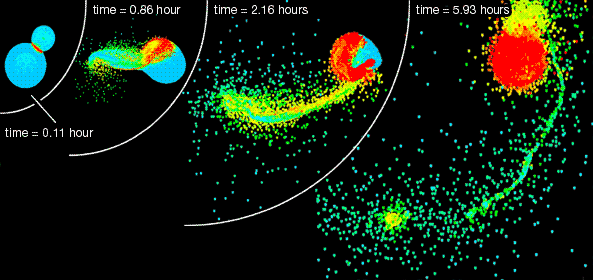One of the questions I am most frequently asked by non-planetary scientists is "How did the Moon form?". My answer invariably involves an explanation of what has become the most commonly accepted scenario and is known as the 'giant impact hypothesis'.
The early history of our solar system was pretty violent. The amount of dust, debris, and projectiles flying around the Sun would have made collisions and impacts a common occurrence. In the giant impact hypothesis scenario, it is thought that an almighty collision between an early-formed (or proto-) Earth and another Mars-sized body—known as Theia—took place approximately 4.5 billion years ago.
 |
| Artist's impression of the hypothesized Moon-forming giant impact event between the proto-Earth and a smaller body known as Theia. Credit: NASA |
The immense amount of energy associated with this event would have been enough to blast apart the impacting Theia and to melt a significant amount of the proto-Earth. The remaining pieces of the obliterated Theia would have been hurled into space and subsequently re-coalesced to form our beloved Moon in orbit around Earth. Computer simulations of the giant impact are varied, but most suggest that Theia impacted Earth at an oblique angle. They also predict most of the material that accreted to form the Moon (more than three quarters) was derived from Theia. The rest of the Moon should therefore have been built from proto-Earth material.
This hypothesis, at face value, is pretty simple to explain and easy to grasp. In any conversation with a non-specialist, however, I tend to leave out several of the problems that are associated with the scenario. And to understand at least one of those, we need to get a bit more technical and talk isotopes. Many of my previous postcards have referred, implicitly or explicitly, to isotopes and their usefulness in several aspects of geology. And I am sure they will continue to crop up, so I thought this was a good a chance as any to actually explain what they are.
We can start with a dictionary definition:
forms of the same element that contain equal numbers of protons, but different numbers of neutrons in their nuclei and hence differ in relative atomic mass, but not in chemical properties
We can also illustrate this with some helpful cartoons. In this case we will focus on oxygen isotopes because they are relevant to this postcard. The most common naturally occurring oxygen isotope—oxygen-16, or 16O—constitutes more than 99% of any given quantity of oxygen. It is known as 16O because it has 16 particles in its nucleus: eight protons (positively charged particles) and eight neutrons (particles with no charge).
 |
| Cartoon of an oxygen-16 atom. There are eight protons (red) and eight neutrons (green) in the nucleus, which is surrounded by eight orbiting electrons (blue). |
The two remaining isotopes are 17O and 18O, which contain an extra one and two neutrons in their nuclei, respectively. All isotopes of a single element have the same number electrons and they therefore exhibit the same chemical characteristics. It is only the mass of the isotopes that changes, due to the variable number of neutrons.
 |
| Cartoons of oxygen-17 (left) and oxygen-18 (right) isotopes (note the additional neutrons). |
So after that chemistry lesson we can get back to the story...
Based on measurements of rocks from the Earth, Mars, and several asteroids, scientists have long thought that the isotopic signatures (e.g., the relative amounts of the three oxygen isotopes) of planetary bodies within the early solar system were variable. They therefore expect Theia and the proto-Earth to have contained different proportions of 16O, 17O, and 18O. If that were indeed the case, and because the majority of Theia ended up in today's Moon, the relative amounts of the three oxygen isotopes that we measure today in lunar and terrestrial rocks should be different. But up until now such differences have not been detected.
In a new study led by Daniel Herwatz at the University of Göttingen, however, small differences between the oxygen (and titanium) isotope abundances in rocks from the Earth and the Moon have now been found. The authors claim that their precise measurement results are therefore evidence to support the giant impact hypothesis.
I don't want to focus here on the details, issues, or implications of their work, but rather on the type of rocks from Earth that they chose to analyse. Herwartz and coauthors compared the composition of basalts from three of the Apollo landing sites with rocks that they decided best represented Earth (sound familiar?). Or at least the most primitive, unaltered part of the Earth. And for this they chose rocks known as mantle xenoliths.
These xenoliths are pieces of Earth's otherwise inaccessible mantle (the region between the crust and core). They are most commonly rocks known as peridotites, which are made up almost entirely of the ultramafic minerals (silicates that have high abundances of magnesium and iron) olivine and/or pyroxene. Xenoliths are brought to the Earth's surface when they are encapsulated and entrained inside other rocks, which crystallize from magmas that originated in the (upper) mantle. Kimberlites—common diamond-bearing rocks—are an example of this geological transportation system. They made the journey from the (almost) centre of the Earth and often contain several samples of this precious mantle cargo.
 |
| My very own little piece of the mantle, a pretty green peridotite. |
Mantle xenoliths are probably the most valuable samples we have for understanding the fundamental composition of the Earth. If they have journeyed this far already, I propose that at least one makes the next leg towards the stars and represents the whole Earth to those alien planetary geologists.

No comments:
Post a Comment